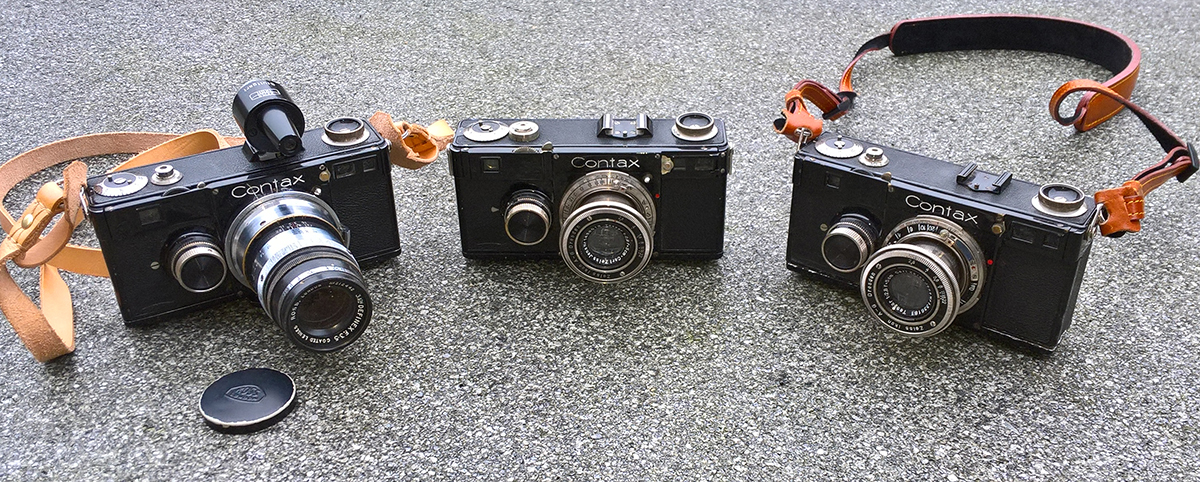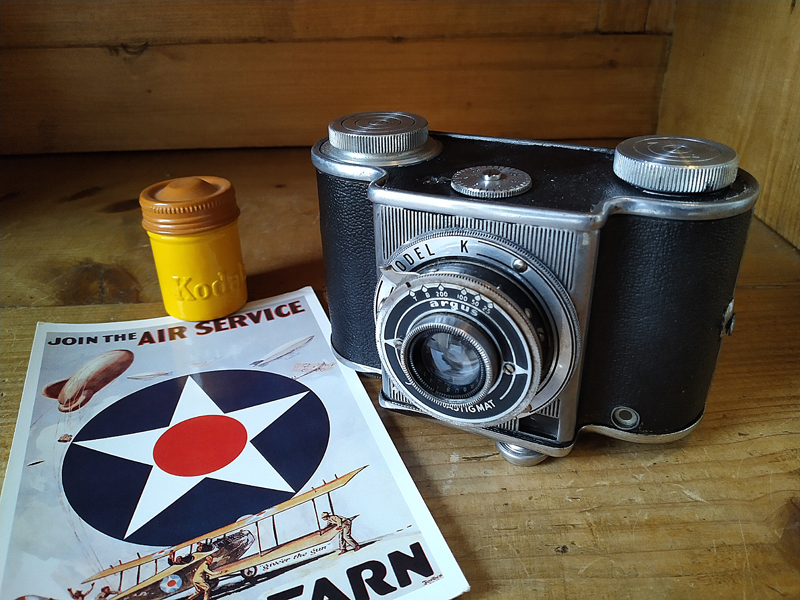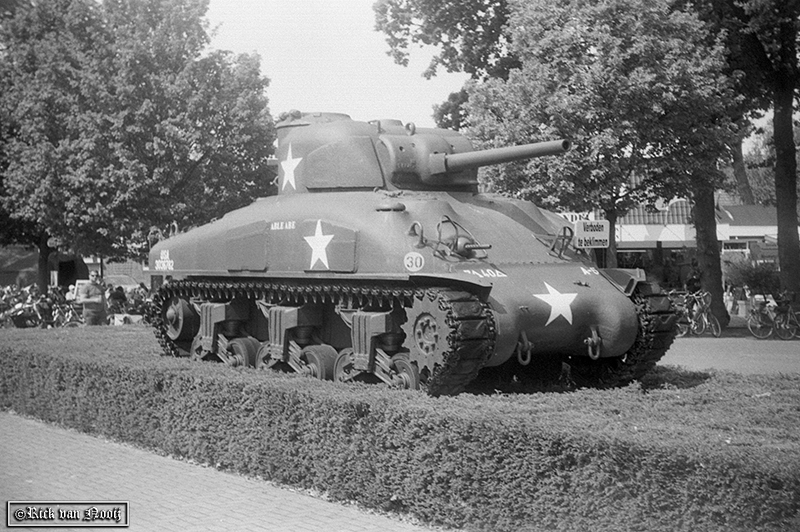You are using an out of date browser. It may not display this or other websites correctly.
You should upgrade or use an alternative browser.
You should upgrade or use an alternative browser.
Uncommon, Rare, and Collector's Delights.
- Thread starter Sonnar Brian
- Start date
- Latest activity Latest activity:
- Replies 657
- Views 68K
Mr_Flibble
In Tabulas Argenteas Refero

Couple of 'uncommon' Contax I cameras. From left to right: version 'd', 'e' and 'c'.
furcafe
Veteran
The 74th Simlar 5cm F1.5.

This is a Double-Gauss 7 element in 4 group design, an uncommon 1-3-2-1 configuration. The Canon 85/1.5 is also a 1-3-2-1 formula lens. The Simlar 5cm F1.5 was computed before WW-II in 1937, same year as the Nikkor 5cm F1.5. Neither lens made it to regular production until after the war. This lens - would consider pre-production. Internally scribed with "10" on parts, the internal screws had to be put back into the same holes they came out of. A real one-off workmanship about it.

When received on a Canon III, the focus was frozen from dried grease. 4 days of soaking in alcohol. This lens takes 39mm filters. Later ones take 40.5mm filters.
Nice. I have a later Simlar (152071) which has a 40mm filter thread (forcing me to use Canon accessories). I sent it to Skyllaney last year to have some fungus removed & a general CLA. Mr. Andreyo considers mine to be a Sonnar-type design ("Front objective, middle triplet, rear doublet. In fact the spacing for the elements, their shape and design even look like the late Zeiss Jena elements.").
p.giannakis
Pan Giannakis
The two Kallo Wides pictured are very nice compact cameras with the superb Kowa 35/2.8 Prominar lens. ......
I used to have the Kowa Kallo W some years ago. It had a nice lens but nothing outstanding.
I was offered quite a bit of money to sell it and i did.

furcafe
Veteran
Also seizing up is more a property of an aluminum helical - my certainly not 'Eastern Block' Steinheil Quinon did it too. The Russians, if anything made the designs much more sensible and streamlined. I'll take a Jupiter-xx focus mount over its German LTM equivalent any day.
Yes, I was too harsh on the Eastern Bloc. Mr. Andreyo noted the poor decision to use an all-aluminum helical rather than a mix of aluminum & brass. Perhaps there was still a brass shortage in the GDR in 1950-1?
Nice. I have a later Simlar (152071) which has a 40mm filter thread (forcing me to use Canon accessories). I sent it to Skyllaney last year to have some fungus removed & a general CLA. Mr. Andreyo considers mine to be a Sonnar-type design ("Front objective, middle triplet, rear doublet. In fact the spacing for the elements, their shape and design even look like the late Zeiss Jena elements.").
Did the later 5cm F1.5 change to a 1-3-2 design! I can see it. The 1-3-2-1 keeps the same number of air/glass interfaces as the classic 6 element in 4 group double-Gauss, 1-2-2-1. The front doublet is split into a triplet, each element of lesser power. Most F1.5 Double-Gauss went with splitting either the rear element for a 1-2-2-1-1 (Xenon, Summarit) or front element, Nikkor 5.8cm F1.4 1-1-2-2-1.
This has been lens week for me. This weekend will be shooting with the 1932 5cm F1.5 Sonnar and the new 50/1 Nokton. Both are among the first 100 made of their type.
TenEleven
Well-known
Good question. I wondered about that too from time to time.Yes, I was too harsh on the Eastern Bloc. Mr. Andreyo noted the poor decision to use an all-aluminum helical rather than a mix of aluminum & brass. Perhaps there was still a brass shortage in the GDR in 1950-1?
It seems like Zeiss switched to aluminum and various alloys during the war shortages (as you already know) and then everyone mostly kept using aluminum and alloys after that. Maybe they discarded the brass dies? Melted them into tank barrels?
However, since a lot of contemporaneous lenses from makers other than Zeiss (I already mentioned Steinheil) also use aluminum. Some (Voigtlander) were smarter about it and went brass/aluminum/brass etc. I wonder whether it was on-going shortages or whether tastes had changed and weight had become an important consideration, especially in the light how (western Germany) Zeiss also expended the utmost effort to make the IIa as small and light as possible. Then there's the curious case of their lenses being all brass, except for the longer bigger ones - which would again point to weight considerations.
I guess that would be an interesting topic for a sleuth like Marco Cavina to explore...
Did the later 5cm F1.5 change to a 1-3-2 design! I can see it. The 1-3-2-1 keeps the same number of air/glass interfaces as the classic 6 element in 4 group double-Gauss, 1-2-2-1. The front doublet is split into a triplet, each element of lesser power. Most F1.5 Double-Gauss went with splitting either the rear element for a 1-2-2-1-1 (Xenon, Summarit) or front element, Nikkor 5.8cm F1.4 1-1-2-2-1.
This has been lens week for me. This weekend will be shooting with the 1932 5cm F1.5 Sonnar and the new 50/1 Nokton. Both are among the first 100 made of their type.
Really curios to hear about your impressions on that 1932 Sonnar - I was really impressed - especially the flatness of field which at least in my copy felt "too good to be true". Also hard to believe it's uncoated - I only caught it misbehaving once, in difficult light and without a hood (I now have managed to acquire the proper hood for it).
Now I'm really curious about the first 5cm f2 Sonnar with the 19mm rear aperture....
dexdog
Veteran
A trio of collapsible 50/2 Sonnars in LTM mount. Yeah, the second pic is really distorted because it is close up on my digital P&S. Anyway, I have had all these lenses apart in the past (even got them back together afterward), and was surprised to discover that all three are a mish-mash of 4 different serial numbers from mid-1930s to 1946. I did not have any serial numbers on the internal parts that correlated with the name ring. I am of the impression that all of these lenses were cobbled together outta spare parts soon after end of WW2. Some of the older members may recall that RFF formerly had a fanatic WW2 Leica camera collector who was also crazy about LTM Sonnars. He bugged me for months to sell him the 271 lens. In the parlance of the time, what part of NO did he not understand, the N or the O?




dexdog
Veteran
The machining and finish of these lenses is pretty good, but the bodies and barrels are a mix of different allows, and strike me a kinda fragile, especially the aluminum clamp/spring on the bottom that locks these things open. I assume that better materials were not available, so CZJ used what they could get. All three have decent glass, that middle lens is just in a bad spot.
TenEleven
Well-known
The machining and finish of these lenses is pretty good, but the bodies and barrels are a mix of different allows, and strike me a kinda fragile, especially the aluminum clamp/spring on the bottom that locks these things open. I assume that better materials were not available, so CZJ used what they could get. All three have decent glass, that middle lens is just in a bad spot.
I have a copy with internally matching numbers. I'd have to dig it out to find out what serial it is though. However like yours the claws are from a rather brittle alloy. I don't think it's aluminum. The glass isn't as nice as yours though - severe schneideritis. I would repaint it but everything in these lenses is very delicate and the materials aren't very sturdy to begin with.
Frankly I'm not a huge fan of this collapsible design - it's better on its native mount, but frankly collapsible lens design is one of the areas where I would admit that Leitz just did a better overall job.
Internal Haze between Leica and Zeiss: After 80 years, both will get internal haze. The Zeiss lenses seem to get more oil on the aperture blades compared with my Leica lenses. The Summitar of the late 1940s and 1950s, seems to get more returning haze than any Zeiss or other Leica lens.
Mr_Flibble
In Tabulas Argenteas Refero

Argus Model K,
A Commemorative Model, to Mark the 100th Anniversary of Photography. Between 1800 or 2100 cameras made according to different sources
mconnealy
Well-known
Hard to top the Argus Model K for rarity. It appears to have been on the market for nine years, so the small number of sales probably has to be called a great market failure. I think that is likely due largely to competition with the company's own products including the A models and the C3. I suspect the manual instructions for using the extinction meter seemed intimidating for prospective users. The placement of the viewfinder also suggests that the camera would best be used while doing a headstand, though regrettably that is not illustrated. The shutter and lens look to be the same as those on the Model A cameras; they were actually pretty good performers. Not many examples on the web of pictures made with the Model K.
furcafe
Veteran
boojum
Ignoble Miscreant
Any other Reid III users?
With a THC Amotal?
Mr_Flibble
In Tabulas Argenteas Refero
Hard to top the Argus Model K for rarity. It appears to have been on the market for nine years, so the small number of sales probably has to be called a great market failure. I think that is likely due largely to competition with the company's own products including the A models and the C3. I suspect the manual instructions for using the extinction meter seemed intimidating for prospective users. The placement of the viewfinder also suggests that the camera would best be used while doing a headstand, though regrettably that is not illustrated. The shutter and lens look to be the same as those on the Model A cameras; they were actually pretty good performers. Not many examples on the web of pictures made with the Model K.
Mine had light leaks, that I've hopefully sealed off now, but I have not tested it since. The decal of the light meter has also deteriorated a bit on my sample. And I expect the aperture control is shifted by a stop or so.
The results I got, pre-leak-fix, were on par with the Argus A series

furcafe
Veteran
With a THC Amotal?
The standard 2-inch f/2 Taylor-Hobson Anastigmat. Not sure if it has the same formula as the Foton's earlier Taylor Taylor & Hobson Cooke Amotal Anastigmat, but also a fine lens.
p.giannakis
Pan Giannakis
A Voigtlander Brillant V6 Focusing with a Heliar 75f/3.5

Vince Lupo
Whatever
Okay I’ll play along — I mean what the heck.
A few things that I’ve posted on RFF over the years — first up is one of my two Ermanoxes. This one is supposedly ‘rarer’ because it’s the early version with the 100/2 Ernostar. Probably even more scarce are the two Rollex-Patent 127 roll film backs.

Ermanox and 127 by Vince Lupo, on Flickr

The boy and his Ermanox by Vince Lupo, on Flickr
This is an odd one — It is a real Leica Standard and its serial number corresponds to the ‘official’ list of Luxus Leicas. Additionally I had the gold finish tested and it is in fact 24k gold plate. I have no idea who did the work — I seem to recall hearing the name of George (can’t recall his last name) out of Chicago who did cameras like this, but I can’t be certain. I actually got a phone call from Luigi Cane out of the blue some years ago and he wanted to talk with me about this camera. The camera is now long gone, but it was definitely a neat one to have.

Leica Standard by Vince Lupo, on Flickr
Not necessarily rare, but definitely a ‘collector’s delight’. It took me quite a while to amass this Contaflex TLR kit and I used every bit of it. I had the camera completely overhauled and it worked beautifully (even the meter). Actually there is one ‘rare’ item in the mix here, and that’s the 28mm f/5.6 lens in the lower right of this photo. Someone converted the lens to work on this camera — it was a scale focus and it worked great. What I ended up doing for framing was to use a Zeiss 28mm finder and put it in a cold shoe that was screwed into the tripod socket of the camera. So I had to use the camera upside down. Worked just fine that way. The kit was ultimately sold to a collector in South Korea some years ago. A super-duper kit that I unfortunately couldn’t justify keeping.

cont1 by Vince Lupo, on Flickr
This was a nice lens — a SOOZI Summicron. Supposedly they only made 550 of them. It was the early days of the M-mount and what Leitz did was to glue an M mount onto a screwmount lens. If you’re lucky and the glue has deteriorated enough, you can easily pry it off without resorting to using heat. The M mount on mine came right off and it worked great on both my screwmount and M-mount bodies. With the hood and caps I paid $400 for it.

soozi2 by Vince Lupo, on Flickr

soozi4 by Vince Lupo, on Flickr

soozi1 by Vince Lupo, on Flickr
Finally, here is one of those KEH ‘bargains’ that I got a number of years ago when they were still asleep at the switch (ah how I miss those days!). It was advertised as a ‘Leica IIIcK repainted black’ for $600. No picture on the website, so I bought it sight-unseen. This is what showed up:

K19 by Vince Lupo, on Flickr

K1 by Vince Lupo, on Flickr

K10 by Vince Lupo, on Flickr

K19 by Vince Lupo, on Flickr
Yup, was a IIIcK repaint, but look at what else it says — FL No. 38079. So not only was it a IIIcK but it was a Luftwaffe IIIcK. For $600. Hmm okay.
A few things that I’ve posted on RFF over the years — first up is one of my two Ermanoxes. This one is supposedly ‘rarer’ because it’s the early version with the 100/2 Ernostar. Probably even more scarce are the two Rollex-Patent 127 roll film backs.

Ermanox and 127 by Vince Lupo, on Flickr

The boy and his Ermanox by Vince Lupo, on Flickr
This is an odd one — It is a real Leica Standard and its serial number corresponds to the ‘official’ list of Luxus Leicas. Additionally I had the gold finish tested and it is in fact 24k gold plate. I have no idea who did the work — I seem to recall hearing the name of George (can’t recall his last name) out of Chicago who did cameras like this, but I can’t be certain. I actually got a phone call from Luigi Cane out of the blue some years ago and he wanted to talk with me about this camera. The camera is now long gone, but it was definitely a neat one to have.

Leica Standard by Vince Lupo, on Flickr
Not necessarily rare, but definitely a ‘collector’s delight’. It took me quite a while to amass this Contaflex TLR kit and I used every bit of it. I had the camera completely overhauled and it worked beautifully (even the meter). Actually there is one ‘rare’ item in the mix here, and that’s the 28mm f/5.6 lens in the lower right of this photo. Someone converted the lens to work on this camera — it was a scale focus and it worked great. What I ended up doing for framing was to use a Zeiss 28mm finder and put it in a cold shoe that was screwed into the tripod socket of the camera. So I had to use the camera upside down. Worked just fine that way. The kit was ultimately sold to a collector in South Korea some years ago. A super-duper kit that I unfortunately couldn’t justify keeping.

cont1 by Vince Lupo, on Flickr
This was a nice lens — a SOOZI Summicron. Supposedly they only made 550 of them. It was the early days of the M-mount and what Leitz did was to glue an M mount onto a screwmount lens. If you’re lucky and the glue has deteriorated enough, you can easily pry it off without resorting to using heat. The M mount on mine came right off and it worked great on both my screwmount and M-mount bodies. With the hood and caps I paid $400 for it.

soozi2 by Vince Lupo, on Flickr

soozi4 by Vince Lupo, on Flickr

soozi1 by Vince Lupo, on Flickr
Finally, here is one of those KEH ‘bargains’ that I got a number of years ago when they were still asleep at the switch (ah how I miss those days!). It was advertised as a ‘Leica IIIcK repainted black’ for $600. No picture on the website, so I bought it sight-unseen. This is what showed up:

K19 by Vince Lupo, on Flickr

K1 by Vince Lupo, on Flickr

K10 by Vince Lupo, on Flickr

K19 by Vince Lupo, on Flickr
Yup, was a IIIcK repaint, but look at what else it says — FL No. 38079. So not only was it a IIIcK but it was a Luftwaffe IIIcK. For $600. Hmm okay.



